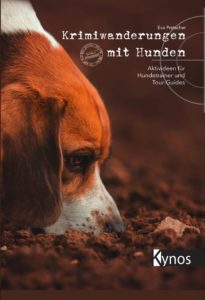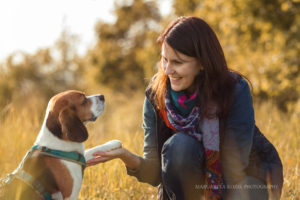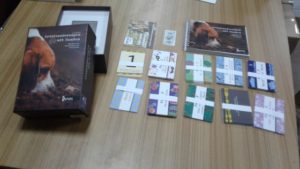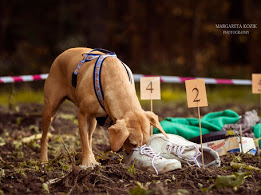
People love crime stories. They also love their dogs. Why not combine the two?
That is exactly what German dog trainer and author Eva Pretscher has done with her new book on canine crime walks. Krimiwanderungen mit Hunden (Kynos Verlag, 2017) will appear at the end of September, but you can learn more and pre-order it at the link above.
Frau Pretscher has developed a series of walks in which dogs and their owners have to work together to solve a fictional crime – a murder mystery, a missing person or animal case, and the like. She sets up scent trails for the dogs and leaves clues for the humans along the trail.
I haven’t seen a more entertaining idea for canine-human activities in a long time.
These canine crime walks have proved so popular in Germany Pretscher is publishing her canine crime walks manual in October. She joins us today to talk about dogs, sleuthing, and having fun. If you prefer to read German, scroll down to the bottom to read the original interview.
Wenn Sie lieber auf Deutsch lesen, finden Sie das ursprünglische Gespräch auf Deutsch ganz unten.
Welcome, Eva Pretscher!

Why is it good to engage a dog with its sense of smell?
Because it’s the most natural activity and occupation for a dog. A dog has fun sniffing and uses smell to perceive its world – when I look at my dog, he would prefer to sniff uninterrupted on a walk.
Your canine crime walks simultaneously engage the dog’s owner with a murder mystery. How does that work?
Exactly. The people have to solve a case following a short introduction to the story, and then it starts. The dog sniffs out the trail and the clues that are necessary to solving the case and the people have to logically connect them to solve the case. Without the olfactory performance of the dog, it would be hard to find the clues, so the people have to rely on the dog’s talents.
With your book, can a dog owner put together canine crime walks him- or herself?
Well, not exactly. There should be a third person to set up/plan the canine crime walks. Otherwise the fun factor would get lost, because if I myself would set up the clues, then there would be no challenge in finding them.

What kind of murder mysteries do you use? Can you give us an example?
They are completely different cases. In the book you’ll find instructions and all the material for 10 cases. They are similarly structured. It always starts with a description of the crime; then comes an inspection of the crime scene, and then the relevant clues that solve the case must be found in the vicinity. And there are various additional puzzles (anagrams or questions to consider…) that always fit to that particular case.
What do you use as an odor to lay the trail for the canine crime walks?
The simplest solution is liverwurst water – it’s easy to prepare and even “inexperienced” noses can smell the trail and follow it well.
Do the dogs also learn something?
Well, of course! 🙂 Even just walking in a group and additionally (in spite of the distraction of other people and dogs) focusing on one person and concentrating on a search task is a challenge for many dogs. Because the individual canine crime walks always take place in different terrains/surroundings, environmental experiences offer another canine highlight.

If a dog proves to be exceptionally talented, are there opportunities to train it further, e.g. for search and rescue?
That opportunity always exists, but is not paramount and isn’t the goal. Many dogs whose owners have noticed that the dog has fun sniffing and searching come to me in my training courses (man-trailing, scent trails, sniffing hours….) and have even more fun with their dog.
Thank you, Eva Pretscher!
Would you like to see Eva Pretscher’s book translated in English? If so, please comment. I’ll be asking the German publisher to check your reactions and if it’s positive, we just might be able to convince the Germans to put a translation on the English-speaking market.
If you liked this post, you might also like:
Volunteer Cadaver Dog Handlers: Might You and Your Dog Make a Good Detective Dog Team? This is an interview with Cat Warren about her NYT bestselling book, What the Dog Knows, and her feisty cadaver dog, Solo. It will appear on the German market next month, and to celebrate that, I’ll be posting a new interview with her in September. Stay tuned!
Archaeology Dogs: Cadaver Dogs on a 700 BC Site is one of my most popular posts ever. I interviewed one of Europe’s foremost cadaver dog handlers on the new field of dogs in archaeology. Andrea Pintar discusses how far back in time a dog’s nose can go. It will amaze you.
Cadaver Dogs: Aiding Law Enforcement throughout History looks at law enforcement’s first intentional use of a dog to search for a dead body. That dog cracked a serial murder case in early 19th-century Germany.

Gespräch mit Eva Pretscher auf Deutsch
Warum ist es gut, einen Hund mit seinem Geruchssinn zu beschäftigen oder spielen zu lassen?
Weil es die natürlichste Beschäftigung und Auslastung von einem Hund ist. Der Hund hat Spaß am Schnüffeln und nimmt darüber seine Welt wahr- wenn ich mir meinen Hund anschaue, schnüffelt er unterwegs am Liebsten ununterbrochen.
Ihre Krimiwanderungen beschäftigen gleichzeitig den/die Hundebesitzer/in mit einem Krimirätsel. Wie funktioniert das?
Genau, die Menschen haben einen Fall zu lösen, nach einer kurzen Einführung in die Story, geht es auch schon los. Der Hund “erschnüffelt” den Weg und die Hinweise die zum Lösen des Falls nötig sind und die Menschen müssen logisch kombinieren um den Fall so zu lösen.
Ohne die Nasenleistung des Hundes wäre es schwer die Hinweise zu finden, somit müssen sich die Menschen auf die Talente des Hundes verlassen.
Mit Ihrem Buch, kann das Herrchen/Frauchen selber eine Krimiwanderung veranstalten?
Naja, nicht ganz. Also es sollte eine dritte Person die Krimiwanderung vorbereiten / auslegen. Denn ansonsten geht der Spaßfaktor verloren, da es, wenn ich selbst für mich selbst die Hinweise auslege, ja keine wirkliche Herausforderung mehr ist, die Hinweise auch zu finden.
Was für ein Krimirätsel benutzen Sie? Könnten Sie uns ein Beispiel geben?
Es sind ganz unterschiedliche Fälle. In dem Buch findet man die Anleitung und das komplette Zubehör für 10 Fälle. Sie sind ähnlich aufgebaut, es geht immer mit einer Beschreibung der Tat los, dann folgt eine Begehung des Tatorts und dann müssen eben genaue Hinweise in der Umgebung gefunden werden, die sachdienlich sind um den Fall zu lösen. Und zusätzlich gibt es auch verschiedene Rätsel (Buchstabenrätsel, Anagramm, oder auch Denkfragen zum Knobeln,…) – immer passend zu dem jeweiligen Fall.
Was verwenden Sie als Geruchsmittel?
Die einfachste Art ist Leberwurstwasser – das lässt sich leicht herstellen und auch “unerfahrene” Schnüffelnasen riechen die Spur und können ihr gut folgen.
Lernen die Hunde auch etwas dabei?
Na klar 🙂 schon alleine das Laufen in einer Gruppe ist für viele Hunde eine Herausforderung und sich zusätzlich (trotz der Ablenkung von anderen Menschen und Hunden) auf seinen Menschen zu fokusieren und sich auf Suchaufgaben zu konzentrieren.
Da die einzelnen Krimiwanderungen immer in einem anderen Gelände / Umgebung stattfinden, kommen Umwelterfahrungen auch noch hinzu.
Wenn ein Hund wirklich gut abschneidet, gibt es Möglichkeiten, ihn weiter zu trainieren, z.B. für Such- und Rettungsdienste?
Die Möglichkeit gibt es immer, dies steht aber nicht im Vordergrund und ist auch nicht das Ziel. Viele der Hunde, bei denen Frauchen/Herrchen gemerkt haben, der Hund hat Spaß am Schnüffeln und Suchen, kommen zu mir in Beschäftigungskurse (Mantrailen, Fährte, Schnüffelstunden,…) und haben hier weiterhin Spaß mit Ihrem Hund.
Danke, Eva Pretscher!
Möchten Sie mehr wissen? Ein Link zum Buch, Krimiwanderungen mit Hunden (Kynos Verlag, 2017).




What a neat idea! My dog Daisy and I have taken a sniffing class and they sent us home with a few games to play, but this takes it to a whole different level. What a wonderful activity for dogs and readers to enjoy together.
Thanks for commenting, Jill. I agree. There’s a market for this kind of activity in the U.S. for sure!
I would love to see this material available to the US English speaking market.
Thanks for commenting, Jill. I’ll make sure the German publisher sees your comment.
I too would love to see these materials available to the US speaking market. I find it very interesting and intriguing.
Me too. I can’t help but think that both the humans and the dogs would have a blast. Thanks for commenting, MaryAnn.
I would love it in English. Very cool idea.
Thanks for commenting, Carmen. I’d love to see it in English, too. Maybe we can convince the German publisher.
Yes, and soon, please! Ten times better than Pokémon Go, and the animal shelters would be emptied in no
time.
You just made me laugh, Mary! At least for me, canine crime walks would be more fun than Pokémon Go. And if more animals got adoped, that would be a good thing. Thanks for commenting!
What a great idea! I would love to do that with my dog! We need this available in the USA!!!
You’re right, Jacqueline — there would be a market for this in the USA. The publisher should really look for an American publishing house for an English translation. People would love doing this with their dogs. Thanks for commenting.